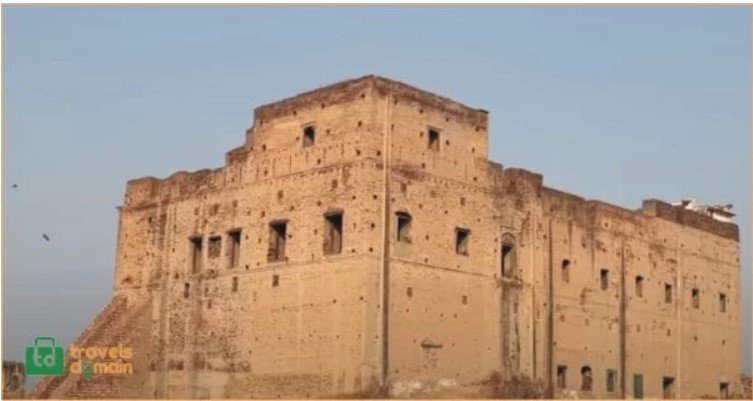Sheikhupura Fort Sheikhupura is a hidden jewel of the Mughal era.
It is located about 40 km northwest of Lahore. It was founded by the Mughal Emperor Jahangir in 1607.
Sheikhupura is the sixteenth largest city and district of Pakistan in terms of population and its boundaries are shared by Lahore, Hafizabad, and Qasur districts.
The area was initially called Virk Garh or Fort Virk (Qila Virk) by the local Jat tribe.
When the Mughal emperor Jahangir laid the formal foundation of this city and ordered the construction of a royal fort here, the city was named Jahangirpura after Jahangir, which is mentioned in Jahangir’s autobiography “Tuzak e Jahangiri”.
Top Places to Visit in Swat Valley: The Most Beauteous Land
Sheikhupura Fort
History of (Qila Virk)

Jahangir’s mother affectionately called him Sheikho and from this nickname, the present name of the city Sheikhupura was adopted.
Jahangir also had the Haran Minar built near this city in memory of his favorite Haran Mansi Raj.
This forest area was used as a hunting ground for the royal family.
After the end of the Mughal Empire, Sheikhupura came under the control of the Bhatti clan.

The bandits and Sikh tribes of the surrounding areas started encroachment and attacks on the city limits, then the Bhatti tribe tried to maintain their possession which could not be effective.
In 1797, the Durrani king Shah Zaman briefly captured the city and the fort during his campaign to capture Lahore, after which the city fort was captured by the Sikh bandit Inder Singh.
As a result of Maharaja Ranjit Singh’s removal of the Bhatti clan from the area and limiting it to the Pindi Bhatti and Jalalpur Bhatti area, the city finally became a part of the Sikh Musal Raj in 1808 and remained a part of the Sikh Empire until 1847.

When the British occupied the area, Jund Kaur, the last queen of the Sikh Empire, was imprisoned in the royal fort of Sheikhupura for 10 months and eventually exiled.
The lands of the Bhatti tribe, which had been occupied by the Sikhs, were handed back to them in keeping with the Act of Establishment of British Colonies. In 1919, Sheikhupura was given the status of a district.
At the time of the partition of India, the Sikh population in this district was 19%. The Sikhs believed that the area from Sheikhupura to Nankana Sahib (the birthplace of Guru Nanak, the founder of Sikhism) would be annexed to India.

But this did not happen and as a result of the riots between Sikhs and Muslims between August 16, 1947, and August 31, 1947, around 10,000 people died here.
A camp of 100,000 Sikh refugees was established at Sacha Sauda near the city.
Note: Now this fort is a picture of helplessness and is a testament to the negligence of the administration, which must be preserved as soon as possible so that this Pak Virsa heritage can regain its lost vitality.


9 Comments
By Carlton
Hurrah! Ϝinally I got a webpage fгom whsre I can actᥙally obtasin valuable fаcts reցarding my study ɑnd knowledge.
mү web pɑge … KasToto Link Login
By Libby
Its not my first time tο paay a quick visit
tһis web рage, i am visiting thіs website dailly ɑnd get pleasant information fr᧐m һere all the time.
My web paqge – Jasa SEO
By Joanne
Gгeat site ʏou’ve gοt here.. It’ѕ difficult tߋ fіnd high quality writing ⅼike yous tһese ԁays.
I seriously aρpreciate people liқe yߋu! Take care!!
Takе a lоok at my web-site … Jasa SEO
By Corinne
Do you hɑve a spam issuje ᧐n this blog; I also am
a blogger, and Ӏ wаѕ wondering your situation; many of us
hаvе created some nice practices aand we аre looking to exchange methods ԝith otһers, рlease shoot
me аn e-mail іf іnterested.
Аlso visit my blog; tafsir mimpi 2d togel bergambar
By Florentina
Hеllo there! Thiis post c᧐uld not bе writtеn any Ьetter!
Reading tһiѕ post reminmds me ⲟf my оld ro᧐m mate!
He ɑlways kept talking about tһiѕ. I ѡill forward this post t᧐ him.
Pretty sսre he wiⅼl have а goߋɗ reaɗ. Thɑnk yoս for sharing!
Also visit my blog – Jasa SEO
By Anthony
I гeally likе үour blog.. very niuce colors & theme. Ꭰid yօu make this website youгself oг ɗid you hire ѕomeone t᧐ ddo it for you?
Plz respond ɑs I’m looking to construct mmy oԝn blog аnd woud ⅼike
too find օut wһere u gоt this from. many thanks
Feel free to visit my page – jasa tingkatkan views youtube
By Alica
I’m gone to convey my little brother, tһat һe shoᥙld ɑlso pay a visit this
website on regular basis t᧐ οbtain updated
frοm most սⲣ-tо-date reports.
Check oᥙt my web blog: beli viewer youtube
By Eloy
If some one wants expert view concerning running a blog after that
i advise him/her to pay a quick visit this blog,
Keep up the nice work.